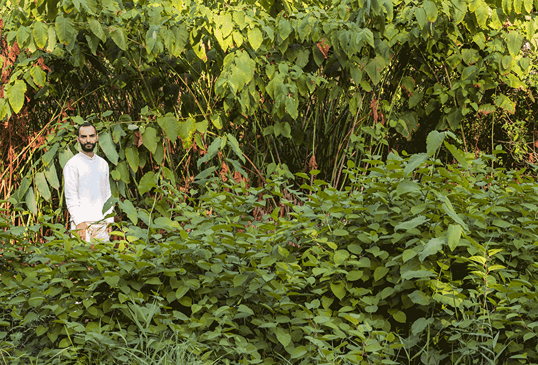
Alaa Abu Asad, The Dog Chased its Tail to Bite it Off, 2018-present (ongoing).
Having lived in Jerusalem and worked in the West Bank, I was familiar with Alaa Abu Asad’s book Wild Plants of Palestine (Jaffat El Aqlam, 2018). When the visual editor of Asymptote asked whether I’d like to highlight the work of an artist whose work traverses borders, especially political and linguistic ones, and who uses text and language(s) in the art sphere, engaging with actual or metaphorical translation, I recalled Abu Asad’s work: his early works on the interpretation of photographs and his focus on place, and specifically his works that speak to the act of translation that occurs when we place ourselves in various landscapes and spaces.I spoke with Rotterdam-based Palestinian artist Alaa Abu Asad via Zoom in March of 2023.
How did language come to figure so prominently in your process and your practice?
I grew up with three languages or, say, two and a half. English is not really spoken in Palestine, but I grew up studying and learning more than one language. In Arabic, my mother tongue, we speak a dialect. We also study formal Arabic as a formal or foreign language. And then we study Hebrew, the language of the State. We practice these languages on a daily basis, especially Arabic, but Hebrew if you go to the shopping mall or the post office or the bank.
In high school, all subjects are taught in Hebrew except Arabic and history. When you graduate, and go to university, everything is Hebrew, and Arabic becomes, suddenly, something that belongs to the past, to your childhood, to your school time. We also study English from a young age. Growing up with three languages makes you very sensitive to language.
I really like these places where languages meet, where they clash, where they overlap. As kids, in school, we would giggle when learning new words that have a completely different meaning in Arabic, like the verb “tease,” in English, “to tease” somebody, because طيز, which sounds the same in Arabic, is “butt.” In English it’s a verb, to tease somebody, to annoy. But in Arabic it just means butt, arse.
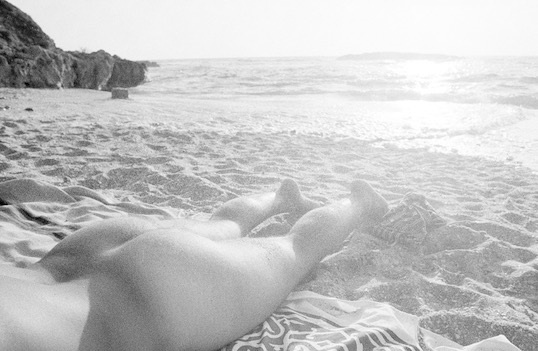
Alaa Abu Asad, Teez [طيز], Tantura Beach, 2012.
Arabic and Hebrew are quite similar, because they’re both Semitic, and they are both root languages. Arabic is more difficult than Hebrew, because it’s more extensive—seriously, it was easier to pass Hebrew than Arabic—because Hebrew is simplified and modernized, while Arabic is not.The foss-ha, فصحى , or Classical Arabic, that we study at school is modernized, standardized Arabic, but it is also very formal. Our brains are not developed to speak this language on a daily basis. Nobody can do that; we speak dialects. Dialects are malleable, flexible. They can contain new words, while the foss-ha is the opposite. I think that the interest in language comes from here.
I’ve lived in the Netherlands now for more than seven years, and I do understand the language to a certain level, but I speak Dutch like a five-year-old kid, because I don’t write in Dutch, and I don’t read books in Dutch. My studies here were in English, and so my work is in English.
Can you talk about how your experience of leaving home has affected your artistic practice?
In Jerusalem, I developed my skills. I owe a lot to my teachers from Bezalel [Academy of Arts and Design]. These were the people who taught me how to read photographs, how to sense the image, the light, how to be very sensitive to small things that I had never thought about, how to print, how to look at colors, how to combine these colors. My bachelor’s program was rich; they gave me all the tools. I don’t know if it’s still the case there, but I really enjoyed my studies, and the experience was empowering. But then you move from one reality into another.
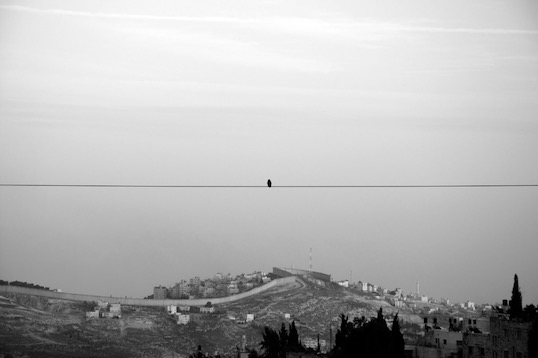
Alaa Abu Asad, Incomplete apartheid wall in Jerusalem, 2010.
The reality in Nazareth, where I grew up, in the north, is completely different from the reality of Jerusalem. In Jerusalem, you’re confronted with the occupation. It’s in front of you. You have to deal with it. The occupation works differently in Nazareth. I would go back to see my parents sometimes and take the bus back to Jerusalem. I remember sitting on the bus and this young soldier got on with a rifle and sat next to me. He fell asleep, and the rifle just tilted, and fell on me.I remember the first time I went to Ramallah from Jerusalem, and I saw the separation wall. On the way to Qalandia. There’s one line. You must take one street straight, and you’ve got the separation wall right next to you. It’s really creepy, but then it becomes normal, which is really sad. The more you do it, the more you’re okay with it, but the first times were shocking.
In school, we had to do some night photography exercises, night exposures. I went with a friend to the old city of Jerusalem, and we got stopped by the soldiers saying, “What are you doing here? Can we see your IDs?” I never carried my ID in Nazareth. These things were new to me.
On the one hand, Jerusalem gave me all the tools to become an artist but, on the other hand, it confronted me with reality. I really grew up in Jerusalem, and I felt at home in Jerusalem for a while. And then I had to graduate.
I left to live in Ramallah. I chose to move because I was so angry with the situation. I had so many friends from Ramallah who could never visit me in Jerusalem. I felt this was so unfair. The settlers can expand and move wherever they want, but my friends—not only my friends, but people who wanted to visit their family or to go to work—had to apply for permission. All this made me so angry. I wanted to leave this place and never wanted to work with the Israelis again, so I just left. I worked for UNRWA (United Nations Relief Works Agency) in Jerusalem, and I lived in Ramallah. It was very difficult, to be honest, it was really draining mentally and physically to travel every day through Qalandia. It killed me.
And now you’re currently living in Rotterdam and have been in the Netherlands for several years since receiving your master’s degree in 2018 at the Dutch Art Institute. How has living in a foreign country impacted your work?
I’m particularly thinking of your project The Dog Chased its Tail to Bite it Off, which focuses on the concept of the “non-native species,” and specifically, the Japanese knotweed, and the parallels that exist between the rhetoric about these plants and anti-immigrant rhetoric in Europe. The words “non-native” or “invasive” carry distinctly negative connotations, whereas then the word “transplant,” the relocation of a plant, can be a positive. For example, we might move plants so they do better in a new location, or, in a health context, we might transplant an organ in an attempt to save a person, or a “transplant” could be someone who has moved and is now embedded in a new place. Do these parallels interest you or influence your work?
I mean, these don’t only influence my work, they also influence my life. My work and my life are always in this mingling, let’s say, but I also agree with the parallels you mentioned. I really agree with them. I also think, for a person who lives in the diaspora, it’s not necessary that their work always be in relation to their status in the diaspora. It can relate, but it shouldn’t be the only option. This is what institutions really like. Because I’m from Palestine: “You have to speak about this.” No, darling, I can do many other things. I have enough troubles to deal with as a Palestinian. I don’t also need to bring this into my work. I want to do things I enjoy, that give me a kind of relief from all these diasporic situations.
What I learned from my Jerusalem experience is that I need to regain a sense of home, and to somehow protect and preserve this sense, because I had lost it. I lived in Jerusalem, and I felt at home, I felt free, I felt freely safe. Weird and bizarre, I know, because Jerusalem is the most unsafe place on different levels. I’m now learning to do this again, to have this feeling of home. It’s quite difficult to understand: Where do I belong?
And this is what drives me to the invasive species. The whole discussion of these species is the question of belonging: What does belong and what doesn’t belong? Why and when and where? These questions belong to a bigger realm: should things be one way or not. In the Netherlands, they have a Dutch saying—“doe normaal”—which means act normally. It’s very bizarre, because, what is normal, or what is acting normally?
So, I’m questioning this. I’m using the topic of the Japanese knotweed, an invasive species in the Netherlands, not only to shed light on the history of colonization—because this plant is a colonial plant, and belongs to the colonial time, was brought as colonial product, or byproduct, if you want—but also, to question this “doe normaal.”
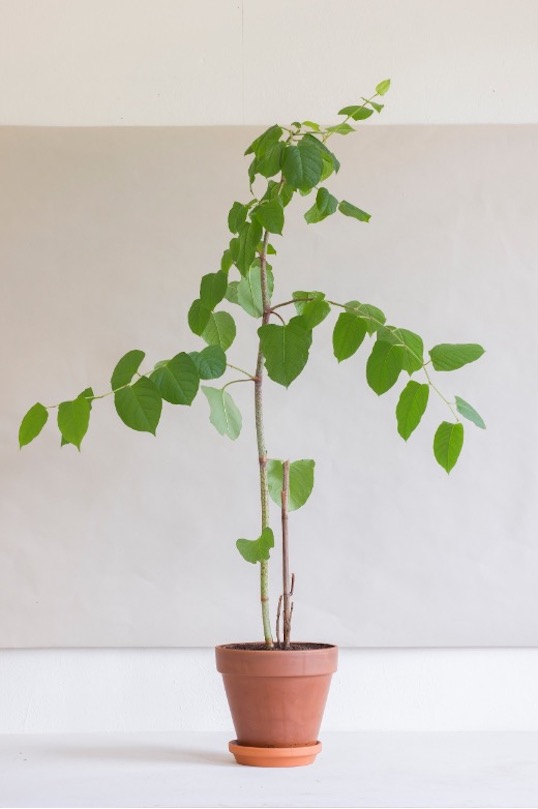
Alaa Abu Asad, Japanese knotweed in terracotta pot, Vienna, 2019.
Why do we consider this plant invasive? And since, when? And based on what? It’s a purely economic calculation in the end. But of course, when you do this research about this topic for so long—I’ve been doing this for more than four years—you can’t not think about the problem of immigration and the human being, and the question of Europe nowadays, of borders, of people moving. When I read or when I watch videos of men speaking about weed control, it’s the same attitude, the same language, they have the same opinions on these things.It’s there. You just need to see it. And it would be bizarre to do all this research, and to say nothing about the human condition. Also, as a Palestinian, it’s something that is imprinted on me that you have to comment on the human condition.
You mention the economic lens that’s used in considering the invasive species, which is very rational—you can see clearly this plant does one thing, or doesn’t do another, and you can calculate those effects, quantify, and make decisions—and yet there are those parallels between the language used when we’re talking about plants and people. We anthropomorphize these plant systems. We talk about them as if they are human systems, or we talk about them the way that we talk about humans.
However, when politicians or anti-immigration activists talk about immigration or borders, the conversation becomes completely irrational. Anybody that looks rationally or quantitatively at the research and the statistics on the benefits of immigration to countries sees it’s nearly always a net benefit. Immigrants bring ideas, or provide labor, as oftentimes they’re going to countries that are aging. There are all these benefits to immigration, not to mention the human rights and moral aspects of supporting and embracing migrants, refugees and asylees. But the conversation is never rational. With these two discussions, there are the parallels, but also telling discrepancies, and this seems to be something that interests you.
Do these ideas thinking about native species, plants, and ethno-botany come out of the interest you had in the natural sciences as a young student, or are they purely a frame for thinking about the human condition?
They come from a personal place of thinking about the human and asking: Where are you in this world? Furthermore, I usually say, I work with invasive pieces, I don’t do work on them. I work together with the plant. Because I’m also, in a way, empowered by this plant. The more I spend time with the plant or looking for it, the more I discover. I learn from the plant. So, my lens is not “looking at the plants,” but working from the field where they grow.
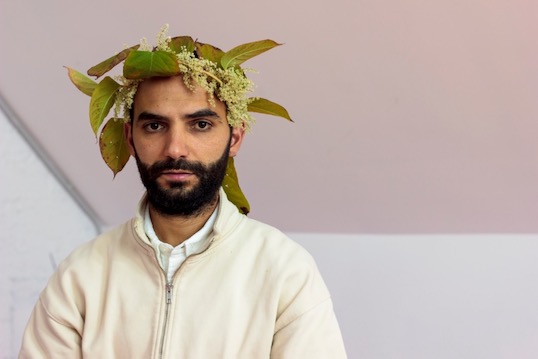
Alaa Abu Asad, Self-portrait with Japanese knotweed crown, Ghent, 2022.
This project, The Dog Chased its Tail to Bite it Off, seems to be your most ambitious project to date in terms of the various formal strategies you employ to pull together various threads from your research on the Japanese knotweed plants. Could you talk about the formation of this project into its various iterations?The Dog Chased its Tail. First, I would like to mention the meaning of the title. You know when the dog tries to chase its tail, and it can’t catch it, but runs in these vicious circles? I was developing this project when I was at the Van Eyck [Residency in 2019], and I had a colleague and friend, doing the program as well, visiting me in my studio, and she brought her kid who had this chocolate egg, a Kinder “surprise”? You open it, and there is a little toy in it. The kid had this, and the toy was a dog that does this, a plastic toy, and he left this for me on my table. I was like, “Oh, my god, this is what my project is about!” Because like this plant, people are in a perpetual fight against it, and it keeps on growing again and again. History repeats itself, because it was brought in as an ornamental plant, and it turned into something else.
I thought about it in the beginning as something textual, text and images, but mainly text. But it never grew in only that direction. The first time I showed this work was in Vienna 2019, and I really didn’t know what to show. The only thing I had were collodion self-portraits, photographs with the plant, and I was fully naked. That was the only thing I had to show, and it was so embarrassing to just show this (also because I was naked in the pictures). So, I literally asked them to take my table, as it is, with everything on it, from my studio to the gallery.
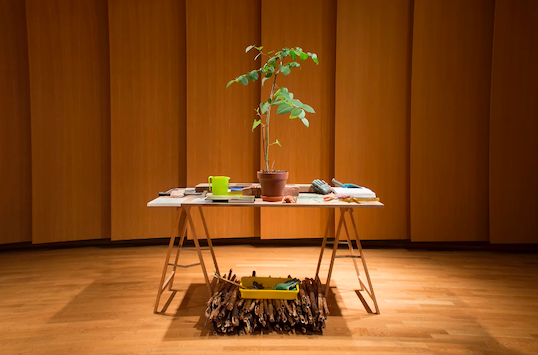
Alaa Abu Asad, Installation view: research material, Japanese knotweed plant, dry sticks, and working tools. KKA Vienna, 2019.
Later on in Maastricht, I was sick, and the pandemic was breaking out, so it was a very weird situation to work with, for open studios for the program there, I collected all the Japanese knotweed branches I could. They were dry, and I put them inside my studio and had all my research material on the walls. I had a sound piece, a speaker in the ceiling reciting all the words, and from there it started to take the shape of the project.Alaa Abu Asad, Sound piece: Research terms from The Dog Chased its Tail to Bite it Off, Maastricht, 2019.
Recently, I did this again at Van Eyck. There was a table and I spoke and then we had a discussion, and this was the format of the work, including the research material itself and including sculpture, in a way, because there is the plant. So far, the format has oscillated between performance, lecture, book, mural installation, some text and image-based essays, video, photography, printed matter, and workshops.You’re very dynamic. You have a capacity to be dynamic in the responses to these various invitations.
In this project everything is reduced to, and framed by, the machinations of the market—the “credit-debit equation” as you say. I thought of this determination as I listened to you read the list of descriptors used in various literature to characterize the Japanese knotweed, and how many of these words can be used to signify the benefit or detriment, how the meaning of the words can change, for example, the words “domesticated,” “wild,” or “dormant.”
Thinking further about how you elaborate this “credit-debit,” it was remarkable to read the lists of other “non-native” species found throughout Europe, plants that are much loved and widely embraced, including the tulip, which is widely recognized as the symbol of the Dutch!
What occurs in this piece, or what you are asking for, is perspectival shift, which, for an artist, is usually one of the goals of a work. Can you talk about how you see your work existing within the art space?
The narrative of the plant is very powerful, as it grapples with various domains of history, society, slavery, gender, ethnobotany, taxonomy, and there’s this relationship between the Netherlands, the Dutch East India company, the Empire of Japan. There is a story there, it’s very interesting.
The plant carries the story with her, because they brought a female specimen of the plant, and it’s almost all female plants growing now. When I tell the story, I feel the magic in the words and the actions and the events and the developments. I see how people get excited and surprised, because they know that this is a “bad” plant, and they say it should be cut down, but they don’t know anything else. When they’re exposed to the long story, which also has humans in it—King Willem I of the Netherlands, Queen Victoria—people get really surprised. The act of telling this story is one of the manifestations of the work itself.
Shifting to your earlier work, I think of the appearance of the red tulips in your piece, Wild Plants of Palestine, which we’ll touch on next, and then in the works you’ve done in Holland, creating beautiful studio still-life pictures of flowering plants typically found on the roadside. In both places, beauty provides an entry point into larger discussions. You talk about how photography, for you, is enjoyable. You go out into the world, and you respond to things. It seems to me the first response is a reaction to beauty which is then followed by distrust and an interrogation, or an unavoidability to place that beauty in a greater context. Can you talk about this idea of entry point or genesis as it relates to these projects?
That makes sense. When I did my studies, there was this huge emphasis on the idea that things shouldn’t only be beautiful, they should have a meaning above all. I’m reacting to and standing against this. I would feel comfortable today to say, “No, actually, it is my right to enjoy things, and the beauty in these things without finding the meaning there,” or maybe the meaning is already in this beauty.
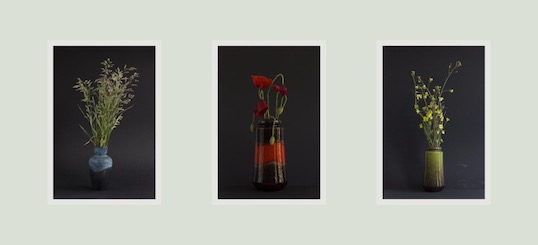
Alaa Abu Asad, [left to right] Bluegrass in Scheurich vase 523–18, W. Germany; Common poppies in Scheurich vase 209–18, W. Germany; Wild rocket, aka arugula or rucola, in Scheurich vase 209–18, W. Germany.
In Wild Plants of Palestine, you recount your first experience encountering tulips in the West Bank and how you came to accompany two professors from Birzeit University on their field missions collecting information about Palestinian flora.The title, Wild Plants of Palestine, was found in the Matson Collection, an archive of images made during British Mandate Palestine (c. 1900–1920), as a part of the colonial enterprise to catalog and document territorial holdings, now housed in the US Library of Congress. There, you found photographs labeled “Wild flowers of Palestine,” from which you made a book and a video piece. The project intersperses archival photographs with your own photographs and video footage showing Israeli settlers attacking Palestinians, among other things. You narrate the video (with closed captions that don’t always match), reading an essay you wrote on the questions these photographs and your experiences looking at them pose. The video ends with the question: “Can an image of the Palestinian landscape ever utterly and truly represent Palestine?” I was curious about your own response to this question. If not, do you think that is a bad thing?
There’s no one single image that can represent America, right? You can’t reduce the place with its numerous experiences and peoples, and differences and complications and conflicts and history into one image. I think that would be unfair.
When I talk to people here, and they see I’m from Palestine, we move to talking about the landscape in Palestine, or let’s say plants. I’m from the north, which is greener than the south, and it could be greener than some parts of Europe. When I mention this, they are like, “No, but isn’t it desert?” No, for me, the desert is something very far. When I visit the desert, I feel outside of my habitat. It’s a strange place to me, but there’s this typical image of what Palestine should look like.
Another thing is, whenever you imagine Palestine—when you imagine you create an image—you always end up with an image of war, of destruction, of—I don’t know—rubble. But life exists in Palestine, and people do things that could be done in New York or Berlin or in Amsterdam, right? That’s why for me, the place cannot be reduced into one image.
But your question is about representing a place: If an image can never truly represent a place, do you think that is a bad thing? I don’t think it’s a bad thing. Because photography is selective.
But, on the other hand, this selection allows you to ask what is beyond that frame, and this is what I was doing with the Matson Collection, asking what is behind and beyond these images that we see. The photography practices in Palestine in the early twentieth century focused on showing the place or the land or the landscape of Palestine. They use photography to satisfy their ideology, meaning that they photographed empty landscapes, the empty swath of the land, to show that culture didn’t exist there; the place was empty and arid, which is not true. It makes me ask why all these images of Palestine, from the Matson collection, are typically restricted or limited to [photographs of] traditional systems, tradition, and craft. I have nothing against these, but it’s as if these were the only things in Palestine, as if bigger cities and trade and shops didn’t exist.
Alaa Abu Asad, Excerpt from video essay, Wild Plants of Palestine, 2018.
Yeah, these photographs, they wanted Palestine to exist in another time that meshes with or matches their concept of the Orient, it’s an Orientalist perspective.A place, especially like Palestine, has multiple stories and different histories, and shouldn’t be reduced to one image which national institutions are busy formulating. National institutions want to create this one image which is valid to them: this is how Palestine looks, or how Palestine should look. They try to say this one image is the real and the only image of Palestine. Any other representations aren’t reliable.
So, it is definitely not a bad thing that one image can’t represent a place. And what I’m stressing is that photography is a very selective lens and medium. What you see in a photograph is a mere selection of reality which the photographer decided to capture. Everything else was cut out and thrown into oblivion. I’ve always been interested in what we don’t see in the photograph. What lies behind the photographer.
I also think that we don’t need to document and photograph everything. Some things are better experienced with our naked eyes and other senses. I always wanted to give a class on how not to photograph, especially in the digital era, and with the availability of cameras in our cell phones. One of the nice exercises I do with myself is to restrict myself not to photograph. I’m really interested in this, in capturing images in your eyes and in your memory and not necessarily registering them with the machine.
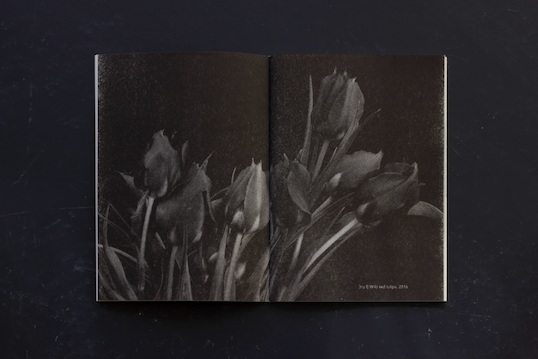
Alaa Abu Asad, Handmade, riso-printed photo essay, Wild Plants of Palestine, 2018.
I like that thinking, hearing about the constraint that you put on yourself to be in a space differently. When you’re talking about these perspectives, including, “what’s behind the photographer,” makes me think about another piece you made early in your career, The Photo War, which looks at the perspectives of the colonizer versus the colonized. In the Matson photographs, we’re seeing the colonizer’s perspective, so thinking about what’s behind, what’s outside of the given perspective is important.But only now we can do this. At that moment, we couldn’t. Now, looking retrospectively, we can do this. I think with the tools that we acquired from literature and from theory, people like Edward Said and others, who commented on this, now we’re able to do this, with their help.
Part of my asking you that question—“Can a photograph represent?”—one thing I wanted to tease out, is that there seems to sometimes be the reaction against photography because it can’t do these things that people say, or think, that it does. It’s people’s misunderstanding of photography that leads to a dismissal and mistrust of the medium altogether.
I think the matter is that photography doesn’t only represent reality. Photography creates reality. Like when you’re experiencing a moment with your kids, you don’t want to bring the camera in, because the camera dictates itself, even without using it, the camera creates an atmosphere. And that’s why even before photographing, this reality is being shaped and created, and it is registered within the photograph itself.
So, I think photography is more about creating reality than representing reality. And I have nothing against this. I actually like this, and sometimes even like the idea that you could create this reality. I can see, in my photographs, subjects as being scared, uncomfortable, and sometimes I just go with it, you know, amplify it. I do maintain the role of photography and like creating an uncomfortable feeling in the room, being the elephant in the room. But it shouldn’t be the only option of how to see reality.
In your work you’re often working with text sources, either gathered from your own writing, or uncovered in your research. How, and when, does text or language enter the creative process for you? I imagine it’s probably ongoing as you uncover things in your research, but do you ever start with a word or start with a phrase?
No, because I was trained as a photographer, working with images. But, I’ve really felt, all the time, that text was there, and it can inspire the work. I read something, and this gives me an idea. And this could be any kind of text: scientific texts, literature, or even traditional proverbs sometimes spark something in me. It can motivate the work, and it can stay there, in that place, not included in the art. But it can also slip into the work, and often text and image work in parallel with me, or sometimes even clash.
It’s not necessarily a text that is written, but also could be something oral. Sometimes I hear something, and it makes me think, and lingers with me. It stays, and I don’t know what to do with it. For example, there is this saying in Arabic, يا دار ما دخلك شرّ, which means—it’s difficult to translate this—that I wish to never have evil in my house, to be protected. It’s very difficult to translate this in a way that parallels the rhymes in Arabic. I’m really thinking about this all the time, “how do you translate this?”
There is a work I did, in 2018, called the Untranslatable Words of Love. It’s about words from an ex-lover that I can’t translate; things like مِشمِش قلبي which means the apricot of my heart. It’s meaningless, but it’s very meaningful.
The Untranslatable Words of Love / مشمش قلبي (screening view), “We Shall be Monsters” exhibition, Qattan Foundation, Ramallah, 2018.
In this piece, I also took the whole text from the Book of Psalms (Psalm 42) and completely changed the translation. I oscillated between God, the land, and love, and it’s shifted from this religious text into something more romantic. It’s a love text. So, this text really fuels the images that you see when you hear it, sometimes I needed to close my eyes and listen to the chant, to see what images it gives. Text is always there: what people say, what you hear, and what you hear, but don’t understand.You are a native Arabic speaker, this interview is being conducted in English, and I’ve read translations to English of your interviews in Dutch. How does living, thinking and creating occur for you within this spectrum of languages?
I think we should exclude English because English is, it’s just like a medium language, you know, it’s nobody’s language, English doesn’t belong to England or to the English people or to the Brits. You know what I mean, it’s everybody’s language.
I’m not a native English speaker, which makes it easier for me to use the language. I don’t need to care about grammar or making mistakes. This gives me more freedom to move into and inside the language itself, and to create things. This is how language becomes a medium in itself, or at least English does, for me, because I don’t treat Arabic the same as I do English.
I think English is not a language as much as it’s a tube that you move in, like you just walk into this tube or through it.
Has language or the art or act of translation become more present since leaving Palestine? I’m also thinking of the psychological translation of self that occurs in everyday life, in the cultural and social interactions, but also, because your work focuses very heavily on place and landscape, the translation of being in the Netherlands where you now live. You remarked on the flatness of the landscape, as opposed to the hilly and arid terrain in Nazareth, where you grew up. There is a daily experience that I can’t help but think of as being translated, in which, in your head there is a constant dialogue: here is not there, there being the constant comparator, your ancestral reference point, Nazareth, which could be conceived as a place from which you translate into the current location or situation. This makes me think of the work of Palestinian poet Mahmoud Darwish, and his grappling with the default or defining position of the exile.
My language has become more mature since I moved to the Netherlands. In the beginning, I was interested in these funny aspects of comparing languages, like the example of the verb “to tease,” and now I pay more attention to what language can, or is unable, to mean. What it can and can’t do. There will always be this dichotomy of here-now-new and there-past-inheritance. We need to learn how to deal with this relationship, as I don’t agree that we should negate one of the two, or find one better than the other. Perhaps, as Darwish says, we, as Palestinians, will always be imprisoned in this position of the exiled. But it doesn’t need to be a weak position or sad, devastating, or limiting. I know it’s a hard place to be, but it doesn’t need to be a weak place. It can also be an empowering place. Perhaps we could reshape the meaning of belonging through this and the unnecessity of a nation-state for being and belonging. People care a lot about the idea of a nation-state, because you want to belong somewhere, but I think the nation-state actually works the other way around. It doesn’t really make you feel that you belong to a place.
Hence comes the translation. How do you translate yourself into your daily life in the places that you move in between, right? I think the most extreme one was in Palestine, because I moved between an Israeli institution, where I studied, and Ramallah, and then back to Nazareth, which was completely different. I dragged the translation with me, not only the language, but also translating myself. I’m not the same person in any of the three places that I mentioned.
I’m interested in how understanding and meaning can align, at times, and at other times diverge. Can you talk a bit about the origin and evolution of a project you created with Ulufer Çelik, I love it when translation can be found to agree with our weird desires, in which you and Ulufer, “spend time together uttering words that are held in common and draw them, discovering whether they carry the same meaning, are slightly different, or are false friends.”
The project consists of a book, a video, and live performances of you and Ulufer reciting words shared between vernacular Palestinian Arabic and Turkish and is described as an “activist tool” intended to be used as a dialogue starter and activity in refugee camps.
First I’ll speak about the title. It’s taken from a text, inspired by or adapted from a sentence by artist Jimmy Durham, from this text called waiting to be interrupted: “I love it when nature is found to agree with our weird desires.” The title is taken from this, and I’m mentioning this to draw on how texts influence the work.
I met Ulufer while studying in the Netherlands. I knew two or three words in Turkish that have the same meaning in Arabic, so I asked her about those, and she asked back about other words. We became friends and started asking each other, each time we met, about words. Then we thought, “Why don’t we do something with this?” So, we decided to do this project, and it started with three words, then became twelve, and now we have, I think, 370 words.
The majority have the same meaning, they sound the same, and they mean the same, but some words have completely different meanings, and it can be very funny sometimes. Friends started to tell us stories. The word hurma حُرمة, in Arabic, means a woman and, in Turkish, means dates, the fruit you eat. This friend, he’s also Turkish, told us this story of Turkish people going to Mecca for pilgrimage and they wanted to buy dates as a gift to take back home, but they asked for hurma, and in Arabic, they’re asking for a woman! So, imagine you’re on pilgrimage and then asking this!
We made a book and a matching card game as a way to activate this, and we’re riso printing sets of the game. We also performed and made short videos. Whenever we perform this in Europe, we think about our audience and make sure or insist that we invite people from different backgrounds. It’s stunning, because we get people from India, from Greece, from Eastern Europe, with so many languages, and they really get many of these words that we use, and they even add things.
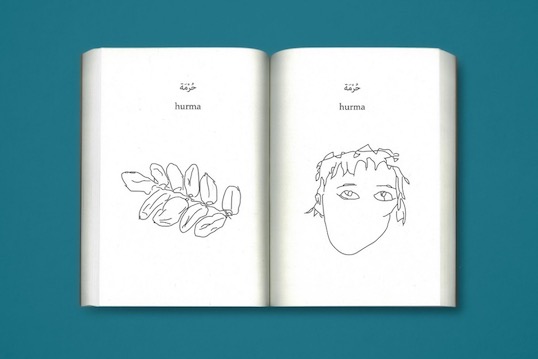
Alaa Abu Asad and Ulufer Çelik, I love it when translation can be found to agree with our weird desires, 2017–present (ongoing). Photo by Peter Chung. Courtesy of the artists.
I’m conflicted, you know, but I would like to return this question to you. Could you think of one thing that represents you as a person? Could you point out one thing? For me, it’s difficult to say if there is one way or one thing or one medium that can perform the work of representation, because I’m already conflicted with the idea of representation.
You know, we live in societies, and we need representation and political representations, etc., but then, we shouldn’t be trapped into this meaning of representation. Because we change and things change, and then representation should change. The presentation of things should be more dynamic.
Also as a Palestinian, if you want to speak about political representation, I think it’s quite problematic: I didn’t choose the colors of the Palestinian flag, or the shape, and I didn’t choose any of the PLO leaders. I can’t even influence this. So, why would I be represented through the national icons, or the so-called leaders? It also makes me think about Israel, as a Jewish state representing Jews in the world. I think that’s problematic, because you can’t reduce the different and the numerous Jewish experiences around the world into one state or into one understanding or into one ideology. And I think that’s even dangerous.
You talk a bit about this in the video piece Wild Plants of Palestine, where you state photography has been “widely misused and misunderstood.” Can you talk about this act of reading a photograph? In your recent work, you’re layering things. Do you think that mistrust of or the potential misuse or misunderstanding of images led you to the more performative works in which you’re able to control the narrative or act as a guide for viewing and digestion.
I say it’s that I would like my viewers to question things, more than I’d like to provide a recipe for how to do it. I want to set out that there’s always this potential of misunderstanding and mis-presenting images. It’s always there. Reading photography or reading images, especially archival material, requires a bit of knowledge or a bit of understanding of the context, otherwise it doesn’t make sense and that’s a bit problematic.
Then I ask about this relationship between the photographed people and the actual photographs: Have they ever had a chance to see these photographs? If yes, what would they feel? It was probably a male photographer, white, coming and photographing them. What was the role of this person, of this camera man? How was this camera man perceived and seen within the Palestinian societies, or within the Palestinian communities?
As you’re speaking, I’m thinking about the writings of Ariella Aïsha Azoulay.
It’s a nice book, recently, from her, Potential History.
She uses that phrase “watching photographs,” which you used last week. We don’t just look, we’re watching, which has more of that aspect you’re talking about: the event that continues, is continued, via the viewers’ presence. I was thinking earlier about the act of bringing a camera into certain events. You’re then watching, and you’re not an active participant necessarily, although she talks about the act of watching as more participatory than viewing.
She says, “This worldly language used photographs as if photography was not a political ontology but a productive practice, reducible to images that bear witness. Photographs were made to bear witness outside of the time, place, and circumstances where they were taken, and not as part of an event in which the spectator participated and in which she could intervene.”
